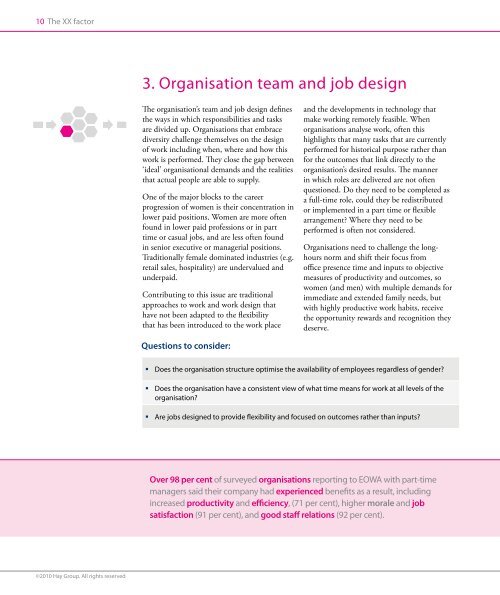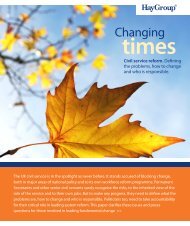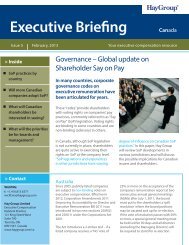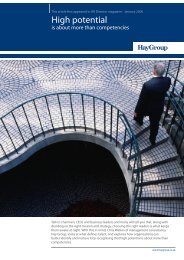The XX factor - Hay Group
The XX factor - Hay Group
The XX factor - Hay Group
You also want an ePaper? Increase the reach of your titles
YUMPU automatically turns print PDFs into web optimized ePapers that Google loves.
10 <strong>The</strong> <strong>XX</strong> <strong>factor</strong><br />
3. Organisation team and job design<br />
<strong>The</strong> organisation’s team and job design defines<br />
the ways in which responsibilities and tasks<br />
are divided up. Organisations that embrace<br />
diversity challenge themselves on the design<br />
of work including when, where and how this<br />
work is performed. <strong>The</strong>y close the gap between<br />
‘ideal’ organisational demands and the realities<br />
that actual people are able to supply.<br />
One of the major blocks to the career<br />
progression of women is their concentration in<br />
lower paid positions. Women are more often<br />
found in lower paid professions or in part<br />
time or casual jobs, and are less often found<br />
in senior executive or managerial positions.<br />
Traditionally female dominated industries (e.g.<br />
retail sales, hospitality) are undervalued and<br />
underpaid.<br />
Contributing to this issue are traditional<br />
approaches to work and work design that<br />
have not been adapted to the flexibility<br />
that has been introduced to the work place<br />
and the developments in technology that<br />
make working remotely feasible. When<br />
organisations analyse work, often this<br />
highlights that many tasks that are currently<br />
performed for historical purpose rather than<br />
for the outcomes that link directly to the<br />
organisation’s desired results. <strong>The</strong> manner<br />
in which roles are delivered are not often<br />
questioned. Do they need to be completed as<br />
a full-time role, could they be redistributed<br />
or implemented in a part time or flexible<br />
arrangement? Where they need to be<br />
performed is often not considered.<br />
Organisations need to challenge the longhours<br />
norm and shift their focus from<br />
office presence time and inputs to objective<br />
measures of productivity and outcomes, so<br />
women (and men) with multiple demands for<br />
immediate and extended family needs, but<br />
with highly productive work habits, receive<br />
the opportunity rewards and recognition they<br />
deserve.<br />
Questions to consider:<br />
• Does the organisation structure optimise the availability of employees regardless of gender?<br />
• Does the organisation have a consistent view of what time means for work at all levels of the<br />
organisation?<br />
• Are jobs designed to provide flexibility and focused on outcomes rather than inputs?<br />
Over 98 per cent of surveyed organisations reporting to EOWA with part-time<br />
managers said their company had experienced benefits as a result, including<br />
increased productivity and efficiency, (71 per cent), higher morale and job<br />
satisfaction (91 per cent), and good staff relations (92 per cent).<br />
©2010 <strong>Hay</strong> <strong>Group</strong>. All rights reserved

















